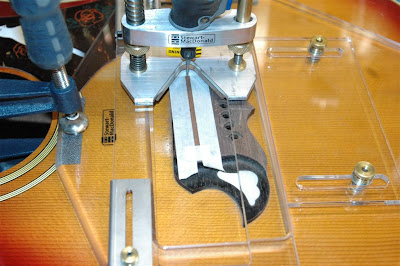Around a year and a half ago, I decided that I wanted to try my hand at building a Selmer-Maccaferri style guitar and thus started jigging up to do so, making molds, bending forms, and other implements of guitarmaking. I didn't get very far in the process when I was approached by a friend of my soon to be father-in-law to build him a dreadnought, so I jumped at the chance to have a paying commission (more on this in coming posts) and put the selmer project on hold. I did, however, build a crazy 12 foot radius dish for the selmer before setting the project aside. Depending on your knowledge of guitarmaking, you may or may not know that average radius for a guitar top is about 25 ft and a guitar back generally around 20 ft, meaning that if you drew a circle with a 25 or 20 ft radius and took a section of the circumference, it would have equal curvature to your guitar top or back. The selmer book/plan that I have calls for a 12 ft radius for both top and back, so I decided to set out making a radius dish for it.
The first step was to figure out the curvature and mark it on a piece of plywood which would eventually become the master template for the dish making jig. There are various ways of calculating this, but a spreadsheet is very handy to do the work for you. There are various calculators available online, but I can't currently find the link to the one I use, and the file is on my other computer at the moment. The measurements were marked almost too precisely on the plywood using my digital calipers, using the point at the end of the caliper jaw as an awl to mark the measurement every centimeter over approximately 2 feet. This is probably the most time consuming step of the process, but I'm a perfectionist, and in guitarmaking, precision accuracy is of the utmost importance. Here it is all marked out:
And a little closer up shot:
After marking, connected the measurement dots and carefully bandsawed outside the resulting curvature, then sanded and filed the curve down to the final shape for the master template:
Next, I made some rails out of 3/4" MDF approximately 3" tall. My router has a round baseplate, so I made a rectangular plate out of 1/2" plywood to mount on the bottom of the router to follow along the rails:
I drilled a hole in my MDF disc that would become the dish to give it an axis to spin on in the jig. Then, I tied the jig together with a few more pieces of plywood and it's ready to route. The routing took quite longer than I expected due to the depth of the dish being a little over 1/2" at the center and the router getting bogged down more the further in it got:
I should say that this is not a project I recommend doing indoors. Even with a vacuum attachment on my router, my shop was literally completely covered in MDF dust. It took quite a while to clean it off of everything. I suppose I could have did a little more searching online, but with the little searching I did I could not find anybody offering 12 ft dishes, so I felt it necessary to make one. Unless I need some odd radius again, I will probably purchase the other dishes I need or route them outdoors. Also, the rails in my jig did sag a little under the weight of the router, so if I were to do it again, I would probably use plywood for them and maybe either double up the rails or add stiffeners to keep them solid. This didn't affect the final product much though, it just required a little cleanup with a random orbital sander and it was good to go. Here is the finished dish with the flat side of the template spanning it to show how deep the 12 ft radius is:




























































